As you may know, File Explorer in Windows 10 runs with the least privileges - only enough permissions that apps need to run are granted by default. This security model was introduced in Windows Vista and is called User Account Control (UAC). As a result, you see a lot of UAC confirmations when trying to browse certain folders and modify files. If you need to operate with protected files, or files owned by another user account, it can be time saving to run File Explorer as Administrator.
Advertisеment
You should not run Explorer as administrator all the time but you might want to run it as administrator to do some file operations that involve lots of UAC prompts. Or maybe some shell extension (e.g. right click menu extension) still hasn't been updated to work with UAC and it fails to work until it is run as admin. There is no Microsoft-provided way to elevate shell extensions that fail to work properly. So rather than always running all apps with UAC set to the default setting, you could set UAC to the highest level permanently and instead temporarily elevate File Explorer in a separate process so you could get your stuff done as admin and then close it.
However, it is not easy to run File Explorer as Administrator. This ability is locked and can't be enabled easily. Here is how you can enable this feature.
To run File Explorer as Administrator in Windows 10, do the following.
- Download the portable app ExecTI and unpack it to any folder you like: Download ExecTI.
- Unblock the downloaded file.
- Using ExecTI, run the "regedit.exe" app. See the screenshot below.
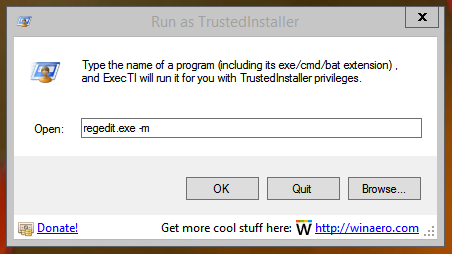 This will open a new instance of the Registry Editor app running with TrustedInstaller permissions, so it will allow you to modify the required Registry key.
This will open a new instance of the Registry Editor app running with TrustedInstaller permissions, so it will allow you to modify the required Registry key.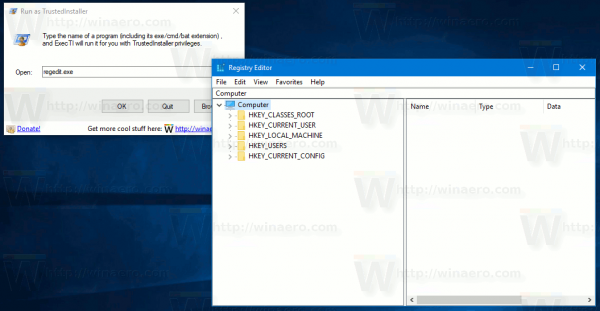
- Go to the following Registry key:
HKEY_CLASSES_ROOT\AppID\{CDCBCFCA-3CDC-436f-A4E2-0E02075250C2}Tip: How to jump to the desired registry key with one click.
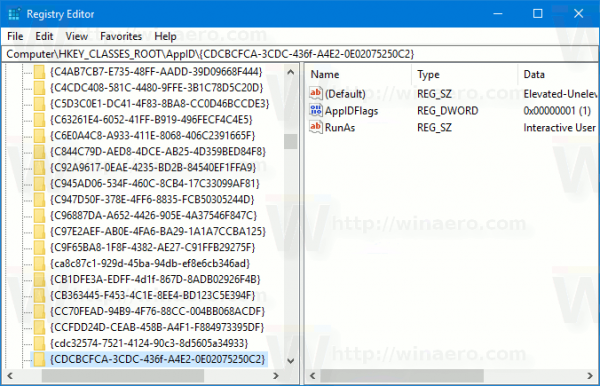
- In the right pane of Registry Editor, you will see a value named 'RunAs'. You need to simply rename this value or delete it so Windows allows you to run Explorer as administrator when you need it. Rename 'RunAs' to anything. For example, RunAs_my (so you remember you made this change).
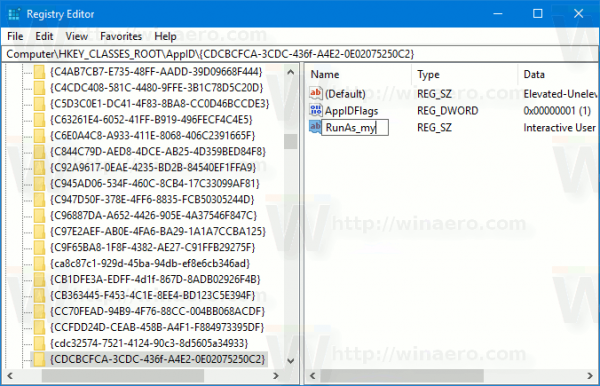
- Close Registry Editor and restart Windows 10.
That's it. Now if you right click the C:\windows\Explorer.exe file and select 'Run as administrator', you will be able to run it as admin!
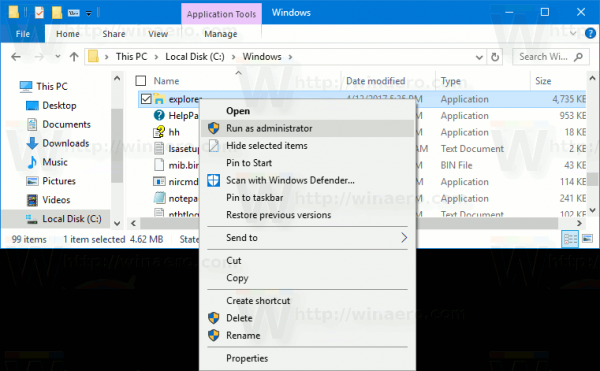
Another way to run it as admin is to start File Explorer from the Start Menu or Start screen by pressing Ctrl+Shift+Enter. It will start as a separate process which you can see in Task Manager.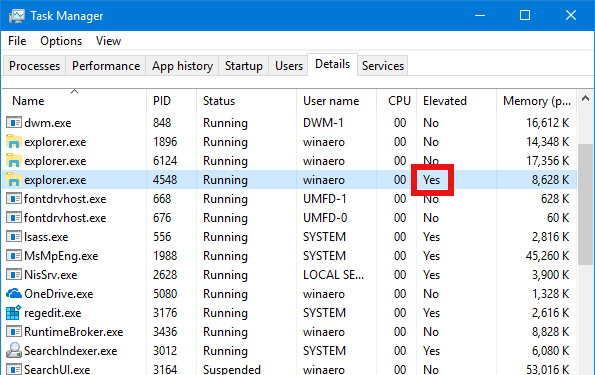
That's it. The solution to run Explorer elevated was found by one of our readers and Windows enthusiast, Andre Ziegler, who pointed the reg key used by the DCOM class in this Technet Forums thread.
Update 5 March 2021. There is an extra method that allows you to run Explorer elevated and avoid Registry editing. However, it will require you to kill all explorer.exe processes, so save all open documents.
Run Explorer Elevated without editing the Registry
- Open Task Manager.
- Find all
explorer.exeprocesses on the Details tab, and click the End task button. This will close all Explorer windows and terminates the taskbar and Desktop.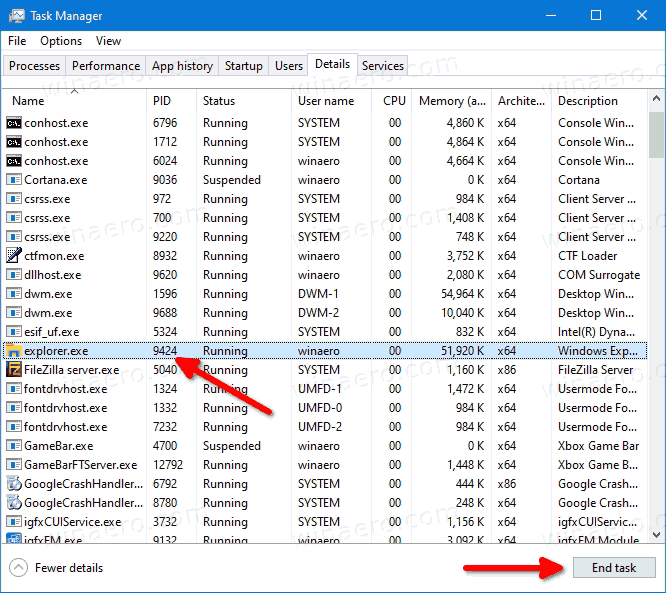
- Click on the menu row and select File > Run new task.
- Enter
explorer.exe /nouaccheckin the Create new task dialog. - Check the Create this task with administrative privileges option, and click the OK button.
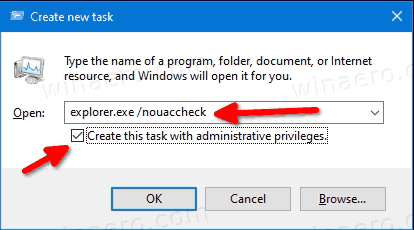
- This will launch Explorer as Administrator.
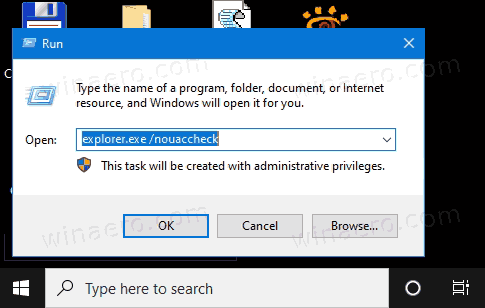
That's it.
Support us
Winaero greatly relies on your support. You can help the site keep bringing you interesting and useful content and software by using these options:

next time, give credits
http://www.msfn.org/board/index.php?showtopic=144776
Fixed.
The problem with this change is that Explorer no longer terminates: If you rename RunAs, and go about your day opening and closing explorer windows, you will eventually find you have dozens of explorer processes running. It is a known issue, as André knows (see https://social.technet.microsoft.com/Forums/windows/en-US/1798a1a7-bd2e-4e42-8e98-0bc715e7f641/unable-to-open-an-elevated-windows-explorer-window?forum=w7itprosecurity)
OK, so somehow I have the reverse problem… I can’t seem to NOT run Explorer as Administrator! Some way, some how I have my system configured so that I am automatically running Explorer as admin, and I can’t get it to run as a regular user. As a result, I can’t access the OneDrive features like sharing, free up space, always keep on device, etc. Further, any explorer-type apps like xplorer2 are automatically running as admin as well, and I just can’t get it out of that mode. Any suggestions will be helpful! //S//
I’ve never seen this while running with normal userids.
I can think of only two situations that could cause this?
You are using userid ADMINISTRATOR (really bad idea) which runs everything as an Administrator because it isn’t supposed to be normally used.
You turned off UAC – don’t know what would happen then.
Sorry – at a loss.
I used your “How to Run File Explorer as Administrator in Windows 10” post and downloaded ExecTI, and ran it according to your instructions setting the HKEY to RunAs my – now I can’t access any drive on my computer!
I’m down for the count – please help me fix this.
There is a much simpler method: If you start File Explorer from an explicit shortcut to it, you can run it with elevated privileges by right-clicking the shortcut and selecting “Run as administrator” from its right-click context-menu. By “explicit shortcut,” I mean one which has the full pathname of the executable (“C:\Windows\explorer.exe”) explicitly specified in the shortcut’s “Target” field.
All you have to do to ensure that this is so is to create the shortcut properly. There are a few ways to do it. The simplest way is to go to the Windows folder, find the executable, “explorer.exe,” right-click it and drag it to wherever you want the shortcut to be. When you release the right button after dragging it, a context-menu of actions will pop up. Select the action “Create shortcut here.” To ensure it worked correctly, inspect the shortcut’s properties by right-clicking the shortcut and then selecting “Properties” from its right-click context-menu.